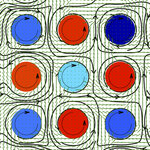Microbiology

The bacterium that causes citrus greening disease, Candidatus Liberibacter asiaticus (CLas), is not only decimating citrus orchards, it also does a number in the guts of the insect that transmits it.
Citrus greening disease, also called Huanglongbing, has taken a terrible toll on Florida's $9 billion citrus industry and infected trees have already been detected in California. It is vector-borne, which means it is spread by insects, namely the Asian citrus psyllid.
But the insects may be getting a bad rap in the blame. As they move from tree to tree, feeding on sap, they transmit it, but…
Nestle, the world's largest food company, has decided to embrace optimizing our microbiome, which consists of trillions of bacteria living in the digestive system and which has been linked to depression, multiple sclerosis, autism - you name it, and someone is claiming their product will fix it.
Why wouldn't they? Our own U.S. government has diverted science funding (even from NASA and the Department of Energy) to jump on the bandwagon with the National Microbiome Initiative, to the tune of over $120 million, about the same money American taxpayers are forced to give to "alternative"…

Microsporidia are typically found in the intestinal tracts of animals and humans, which are made up of millions of cells, which is why studying their mode of reproduction has been so difficult. Yet it's important. Microsporidia cause diarrhea, an illness called microsporidiosis, and even death in immune-compromised individuals.
In spite of those known widespread medical problems, scientists were uncertain about how these single-celled fungi reproduced in human or animal cells. In a study that employed transparent roundworms, biologists at the University of California San Diego succeeded…

Bacteria transfer to candy that has fallen on the floor no matter how fast you pick it up.
Rutgers researchers have disproven the widely accepted notion that it's OK to scoop up food and eat it within a "safe" five-second window. Donald Schaffner, professor and extension specialist in food science, found that moisture, type of surface and contact time all contribute to cross-contamination. In some instances, the transfer begins in less than one second. Their findings appear online in the American Society for Microbiology's journal, Applied and Environmental Microbiology.
"The popular…

You recently saw how a build-up of microbes in bagpipes recently doomed a Scottish man. That could apply to all wind instruments, and a U.S. Food and Drug Administration microbiologist warns that several species of bacteria found in smokeless tobacco products have been associated with opportunistic infections.
Obviously that doesn't mean they caused them but associations are important in making health policy, and alternatives to cigarette smoking, in the interests of harm reduction and smoking cessation, are controversial, with the U.S. government being squarely against them, a legacy of…

Many of society’s energy challenges require gigawatts of power, but many more are small – and some are entirely microscopic. To drive a new generation of tiny micromachines that could deliver drugs or clean traces of pollution, physicists are increasingly looking to biology for inspiration.
In work published in the journal Science Advances, my co-authors and I present a simulation of a sort of tiny “windfarm” powered by the natural self-organization of bacteria. It’s a small step towards harnessing the energy potential of microorganisms.
Active fluid-powered windfarms
We used computer…

What research looks like when it is and is not performed by scientists
Food safety laws and regulations are constantly evolving; from what initially began as a basic and patchwork start to today’s highly technical fact, relying on leading science to inform and improve what is, and isn’t, permitted. Our food system is regulated to be safe, but that doesn’t mean it can deliver foods that are 100% pure, such as bread, grains, fruits, and vegetables. In the process of producing and harvesting agricultural ingredients, small fragments of other material are gathered as well. This could be…

No one knows for sure how they got there. But the discovery that bacteria that normally live in the gut can be detected in the lungs of critically ill people and animals could mean a lot for intensive care patients.
Today, scientists are reporting that they found gut bacteria in the deepest reaches of failing lungs -- an environment where they normally aren't found and can't survive. The more severe the patients' critical illness, the more their usual lung bacteria were outnumbered by the misplaced gut bugs.
The findings, published in Nature Microbiology, were made by a team at the…

Beer is the world's most commonly fermented beverage and lager beer commands 94 percent of the global market. Making the beer possible is a biological oddity: a hybrid yeast that combines two distinct species and confers the ability to make cold-brewed beer, a product that first emerged 500 years ago in Europe.
Without question, the domesticated hybrid yeast that gives us lager beer is an organism worth many billions of dollars, but just how Saccharomyces cerevisiae, the well-known domesticated yeast that gives us wine and bread, combined with Saccharomyces eubayanus, a yeast species…

Gut microbes are all the rage and scholars everywhere are latching onto the fad. If you are over the age of 30, you have seen this too many times to count. Sugar causes diabetes, salt causes heart disease, trans fats cause everything, saturated fats were bad until they were good.
Now a paper in Nature claims an altered gut microbiota causes obesity.
In an earlier study, Gerald I. Shulman, M.D., the George R. Cowgill Professor of Medicine, observed that acetate, a short-chain fatty acid, stimulated the secretion of insulin in rodents. To learn more about acetate's role,…